Cu–Polymetallic Deposit Exploration under Thick Cover in Gucheng–Yaxi Area Using Audio-Magnetotelluric and Spread-Spectrum-Induced Polarization
Abstract
1. Introduction
2. Geological Background
3. Method
3.1. Audio-Magnetotellurics
3.2. Spread-Spectrum-Induced Polarization Method
3.3. Audio-Magnetotelluric Instruments
3.4. SSIP Working Principles and Parameters
4. Data Acquisition and Processing
4.1. AMT Data Acquisition
4.2. SSIP Data Acquisition
5. Data Analysis
5.1. Apparent Resistivity-Phase Curves and Pseudo-Sections
5.2. Dimensionality Analysis
5.3. Geoelectric Strike Estimation
6. Two-Dimensional Inversion
6.1. Audio-Magnetotellurics
6.2. SSIP
7. Results and Discussion
7.1. AMT and SSIP
7.2. Borehole Verification
8. Conclusions
Author Contributions
Funding
Data Availability Statement
Conflicts of Interest
References
- Yan, J.; Liu, X.; Wang, S.; Xie, J.; Liu, J. Metallogenic type controlled by magma source and tectonic regime: Geochemical comparisons of Mesozoic magmatism between the Middle–Lower Yangtze River Belt and the Dabie Orogen, eastern China. Ore Geol. Rev. 2021, 133, 104095. [Google Scholar] [CrossRef]
- Calvo, G.; Valero, A. Strategic mineral resources: Availability and future estimations for the renewable energy sector. Environ. Dev. 2022, 41, 100640. [Google Scholar] [CrossRef]
- Nate, S.; Bilan, Y.; Kurylo, M.; Lyashenko, O.; Napieralski, P.; Kharlamova, G. Mineral policy within the framework of limited critical resources and a green energy transition. Energies 2021, 14, 2688. [Google Scholar] [CrossRef]
- Sovacool, B.K.; Ali, S.H.; Bazilian, M.; Radley, B.; Nemery, B.; Okatz, J.; Mulvaney, D. Sustainable minerals and metals for a low-carbon future. Science 2020, 367, 30–33. [Google Scholar] [CrossRef] [PubMed]
- Ali, S.H.; Giurco, D.; Arndt, N.; Nickless, E.; Brown, G.; Demetriades, A.; Durrheim, R.; Enriquez, M.A.; Kinnaird, J.; Littleboy, A. Mineral supply for sustainable development requires resource governance. Nature 2017, 543, 367–372. [Google Scholar] [CrossRef]
- Fan, E.; Li, L.; Wang, Z.; Lin, J.; Huang, Y.; Yao, Y.; Chen, R.; Wu, F. Sustainable recycling technology for Li-ion batteries and beyond: Challenges and future prospects. Chem. Rev. 2020, 120, 7020–7063. [Google Scholar] [CrossRef]
- Nickless, E. Resourcing future generations: A contribution by the earth science community. Nat. Resour. Res. 2018, 27, 143–158. [Google Scholar] [CrossRef]
- Mikhailov, A.G.; Vashlaev, I.I. The Technology of Upward Capillary Formation of Waste for Creating a Deposit before Land Reclamation. Adv. Environ. Eng. Res. 2022, 3, 15. [Google Scholar] [CrossRef]
- Embeng, S.B.N.; Meying, A.; Ndougsa-Mbarga, T.; Moreira, C.A.; Amougou, O.U.O. Delineation and Quasi-3D Modeling of Gold Mineralization Using Self-Potential (SP), Electrical Resistivity Tomography (ERT), and Induced Polarization (IP) Methods in Yassa Village, Adamawa, Cameroon: A Case Study. Pure Appl. Geophys. 2022, 179, 795–815. [Google Scholar] [CrossRef]
- Cortês, A.R.P.; Moreira, C.A.; Paes, R.A.S.; Veloso, D.I.K. Geophysical and metalogenetic modelling of the copper occurrence in Camaquã Sedimentary Basin, Brazilian Southern. Pure Appl. Geophys. 2019, 176, 4955–4968. [Google Scholar] [CrossRef]
- Parasnis, D.S. Principles of Applied Geophysics; Springer Science & Business Media: Berlin/Heidelberg, Germany, 2012. [Google Scholar]
- Guo, Z.; Xue, G.; Liu, J.; Wu, X. Electromagnetic methods for mineral exploration in China: A review. Ore Geol. Rev. 2020, 118, 103357. [Google Scholar] [CrossRef]
- Smith, R. Electromagnetic induction methods in mining geophysics from 2008 to 2012. Surv. Geophys. 2014, 35, 123–156. [Google Scholar] [CrossRef]
- Xi, X.; Yang, H.; He, L.; Chen, R. Chromite mapping using induced polarization method based on spread spectrum technology. In Proceedings of the Symposium on the Application of Geophysics to Engineering and Environmental Problems 2013, Denver, CO, USA, 17–21 March 2013; pp. 13–19. [Google Scholar]
- He, L.; Chen, L.; Dorji; Xi, X.; Zhao, X.; Chen, R.; Yao, H. Mapping the geothermal system using AMT and MT in the Mapamyum (QP) field, Lake Manasarovar, Southwestern Tibet. Energies 2016, 9, 855. [Google Scholar] [CrossRef]
- Lv, H.; Xu, L.; Yang, B.; Su, P.; Xu, H.; Wang, H.; Yao, C.; Su, P. Mineralization Based on CSAMT and SIP Sounding Data: A Case Study on the Hadamengou Gold Deposit in Inner Mongolia. Minerals 2022, 12, 1404. [Google Scholar] [CrossRef]
- Zonge, K.L.; Hughes, L.J. Controlled Source Audio-Frequency Magnetotellurics. 1991. Available online: https://pubs.geoscienceworld.org/ (accessed on 24 January 2024).
- Revil, A.; Vaudelet, P.; Su, Z.; Chen, R. Induced polarization as a tool to assess mineral deposits: A review. Minerals 2022, 12, 571. [Google Scholar] [CrossRef]
- He, L.; Chen, L.; Dorji; He, Z.; Wang, X.; Xiao, B.; Xu, L.; Zhao, X.; Xi, X.; Yao, H. Mapping chromite deposits with audio magnetotellurics in the Luobusa ophiolite of southern Tibet. Geophysics 2018, 83, B47–B57. [Google Scholar] [CrossRef]
- Yan, L. Advancements in controlled source electromagnetic methods for prospecting unconventional hydrocarbon resources in China. Surv. Geophys. 2023, 45, 239–276. [Google Scholar] [CrossRef]
- Xue, G.-Q. The development of near-source electromagnetic methods in China. J. Environ. Eng. Geophys. 2018, 23, 115–124. [Google Scholar] [CrossRef]
- Ahmed, I.; Liu, H.; Chen, R.; Ahmad, J.; Shah, S.A.; Fahad, S.; Rahim, O.A.; Ullah, F.; Rui, L. Geothermal Resource Exploration in Reshi Town by Integrated Geophysical Methods. Energies 2024, 17, 856. [Google Scholar] [CrossRef]
- Liu, W.; Chen, R.; Cai, H.; Luo, W. Robust statistical methods for impulse noise suppressing of spread spectrum induced polarization data, with application to a mine site, Gansu province, China. J. Appl. Geophys. 2016, 135, 397–407. [Google Scholar] [CrossRef]
- XiaoChun, X.; XinYue, X.; QiaoQin, X.; ZhongYang, F.; ShiLong, Q.; Zujun, X. Geological and geochemical characteristics and genesis of the Chating copper-gold deposit in Xuancheng City, Anhui Province. Acta Petrol. Sin. 2019, 35, 3659–3676. [Google Scholar] [CrossRef]
- Xu, X.-y.; Xu, X.-c.; Xie, Q.-q.; Fu, Z.-y.; Lu, S.-m.; Zhao, L.-l. Geological features and ore-forming mechanisms of the Chating Cu–Au deposit: A rare case of porphyry deposit in the Middle–Lower Yangtze River metallogenic belt. Ore Geol. Rev. 2022, 144, 104860. [Google Scholar] [CrossRef]
- Qi, H.; Lu, S.; Yang, X.; Zhao, L.; Zhou, Y.; Deng, J.; Li, J. Genesis of Cretaceous igneous rocks and its related large scale porphyry Cu-Au mineralization in Chating, the Middle-Lower Yangtze River Metallogenic Belt: The geochemical constrains. Ore Geol. Rev. 2020, 127, 103793. [Google Scholar] [CrossRef]
- Lu, S.; Yang, Q.; Qi, H.; Li, J.; Qian, S.; Zhao, L. A geological-geophysical model for the Chating copper-gold deposit, Xuancheng, Anhui Province. Acta Geol. Sin.—Engl. Ed. 2019, 93, 243–244. [Google Scholar] [CrossRef]
- Xiao, Q.; Zhou, T.; Hollings, P.; Wang, S.; Liu, J.; White, N.; Fu, B.; Yuan, F. The role of porphyry-related skarns in the Chating porphyry copper and gold deposit, eastern China. Ore Geol. Rev. 2021, 133, 104096. [Google Scholar] [CrossRef]
- Tikhonov, A. On determining electrical characteristics of the deep layers of the Earth’s crust. Dokl. Akad. Nauk. SSSR 1950, 73, 295–297. [Google Scholar]
- Cagniard, L. Basic theory of the magneto-telluric method of geophysical prospecting. Geophysics 1953, 18, 605–635. [Google Scholar] [CrossRef]
- Cantwell, T. Detection and Analysis of Low Frequency Magnetotelluric Signals. Ph.D. Thesis, Massachusetts Institute of Technology, Cambridge, MA, USA, 1960. [Google Scholar]
- Cantwell, T.; Madden, T. Preliminary report on crustal magnetotelluric measurements. J. Geophys. Res. 1960, 65, 4202–4205. [Google Scholar] [CrossRef]
- Vozoff, K. The magnetotelluric method in the exploration of sedimentary basins. Geophysics 1972, 37, 98–141. [Google Scholar] [CrossRef]
- Price, A. The theory of magnetotelluric methods when the source field is considered. J. Geophys. Res. 1962, 67, 1907–1918. [Google Scholar] [CrossRef]
- Chave, A.D.; Jones, A.G. The Magnetotelluric Method: Theory and Practice; Cambridge University Press: Cambridge, UK, 2012. [Google Scholar]
- Nabighian, M.N. Electromagnetic Methods in Applied Geophysics: Voume 1, Theory; Society of Exploration Geophysicists: Houston, TX, USA, 1988. [Google Scholar]
- GSAI. Internet of Things Broadband Magnetotelluric Instrument GSEM-W10. Available online: https://www.gs-ait.com/en/ (accessed on 24 January 2024).
- Liu, W.; Chen, R.; Cai, H.; Luo, W.; Revil, A. Correlation analysis for spread-spectrum induced-polarization signal processing in electromagnetically noisy environments. Geophysics 2017, 82, E243–E256. [Google Scholar] [CrossRef]
- Chun, S.-h.; Chen, R.-j.; Geng, M.-h. Review of the pseudo-random m sequence and its application in electrical prospecting of exploration geophysics. Prog. Geophys. 2014, 29, 439–446. [Google Scholar]
- He, S.; Guan, J.; Chen, D.; Xu, H.; Wang, Y. A fusion approach for suppression of environmental noise in spread spectrum induced polarization data. Pure Appl. Geophys. 2021, 178, 3619–3628. [Google Scholar] [CrossRef]
- GSAI Geophysics. Electromagnetic Data Processing Software GSEM-Pros; GSAI: Changsha, China, 2024. [Google Scholar]
- Kirkby, A.L.; Zhang, F.; Peacock, J.; Hassan, R.; Duan, J. The MTPy software package for magnetotelluric data analysis and visualisation. J. Open Source Softw. 2019, 4, 1358. [Google Scholar] [CrossRef]
- Krieger, L.; Peacock, J.R. MTpy: A Python toolbox for magnetotellurics. Comput. Geosci. 2014, 72, 167–175. [Google Scholar] [CrossRef]
- Caldwell, T.G.; Bibby, H.M.; Brown, C. The magnetotelluric phase tensor. Geophys. J. Int. 2004, 158, 457–469. [Google Scholar] [CrossRef]
- Booker, J.R. The magnetotelluric phase tensor: A critical review. Surv. Geophys. 2014, 35, 7–40. [Google Scholar] [CrossRef]
- Ren, W.; Ren, Z.; Xue, G.; Chen, W.; Zhao, P.; Liu, J. Three-dimensional audio magnetotelluric imaging of the Yangyi geothermal field in Tibet, China. J. Appl. Geophys. 2023, 211, 104966. [Google Scholar] [CrossRef]
- Pedersen, L.B.; Engels, M. Routine 2D inversion of magnetotelluric data using the determinant of the impedance tensor. Geophysics 2005, 70, G33–G41. [Google Scholar] [CrossRef]
- Niasari, S.W. A short introduction to geological strike and geo-electrical strike. AIP Conf. Proc. 2016, 1755, 100002. [Google Scholar]
- Weaver, J.T.; Agarwal, A.K.; Lilley, F. Characterization of the magnetotelluric tensor in terms of its invariants. Geophys. J. Int. 2000, 141, 321–336. [Google Scholar] [CrossRef]
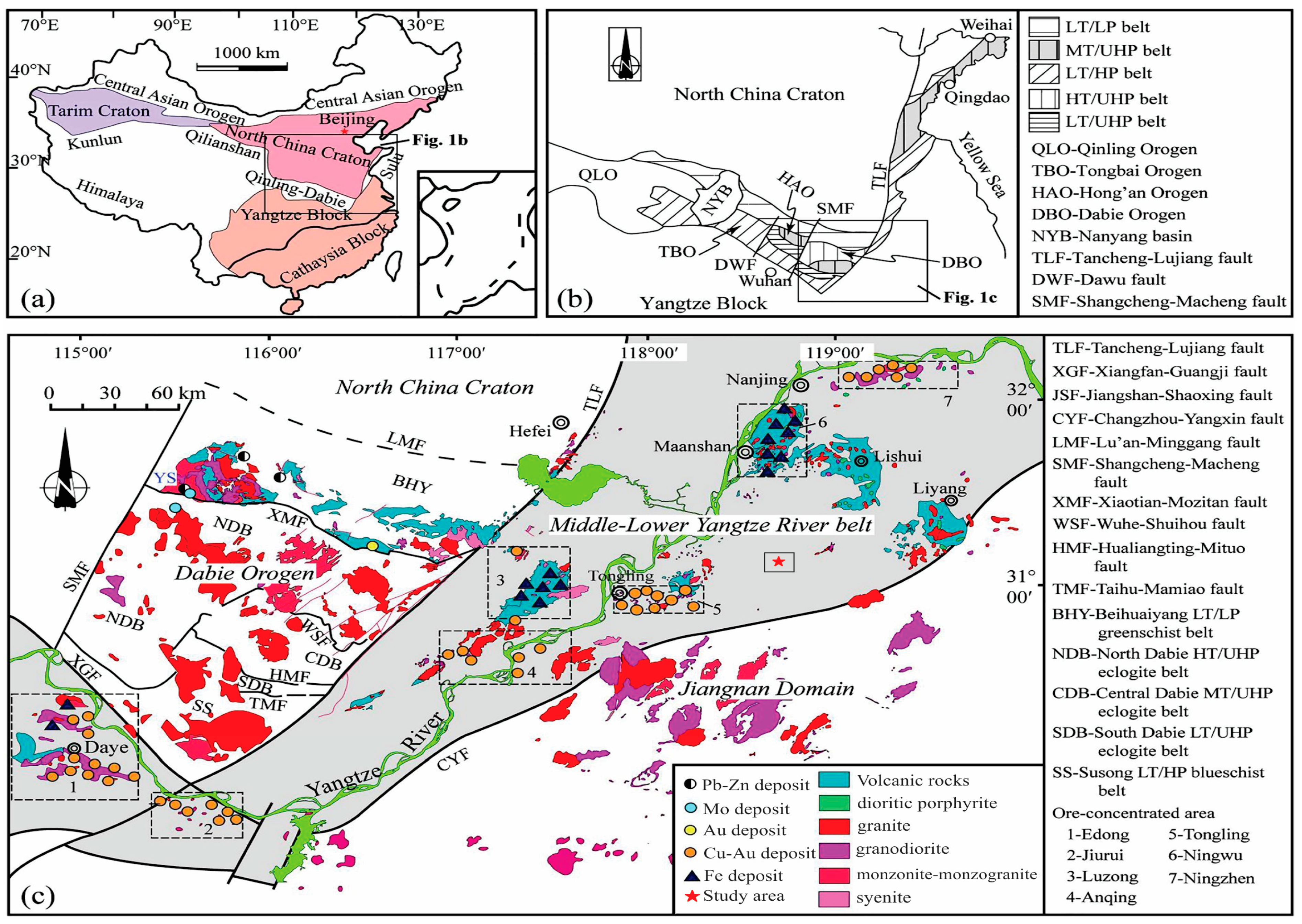
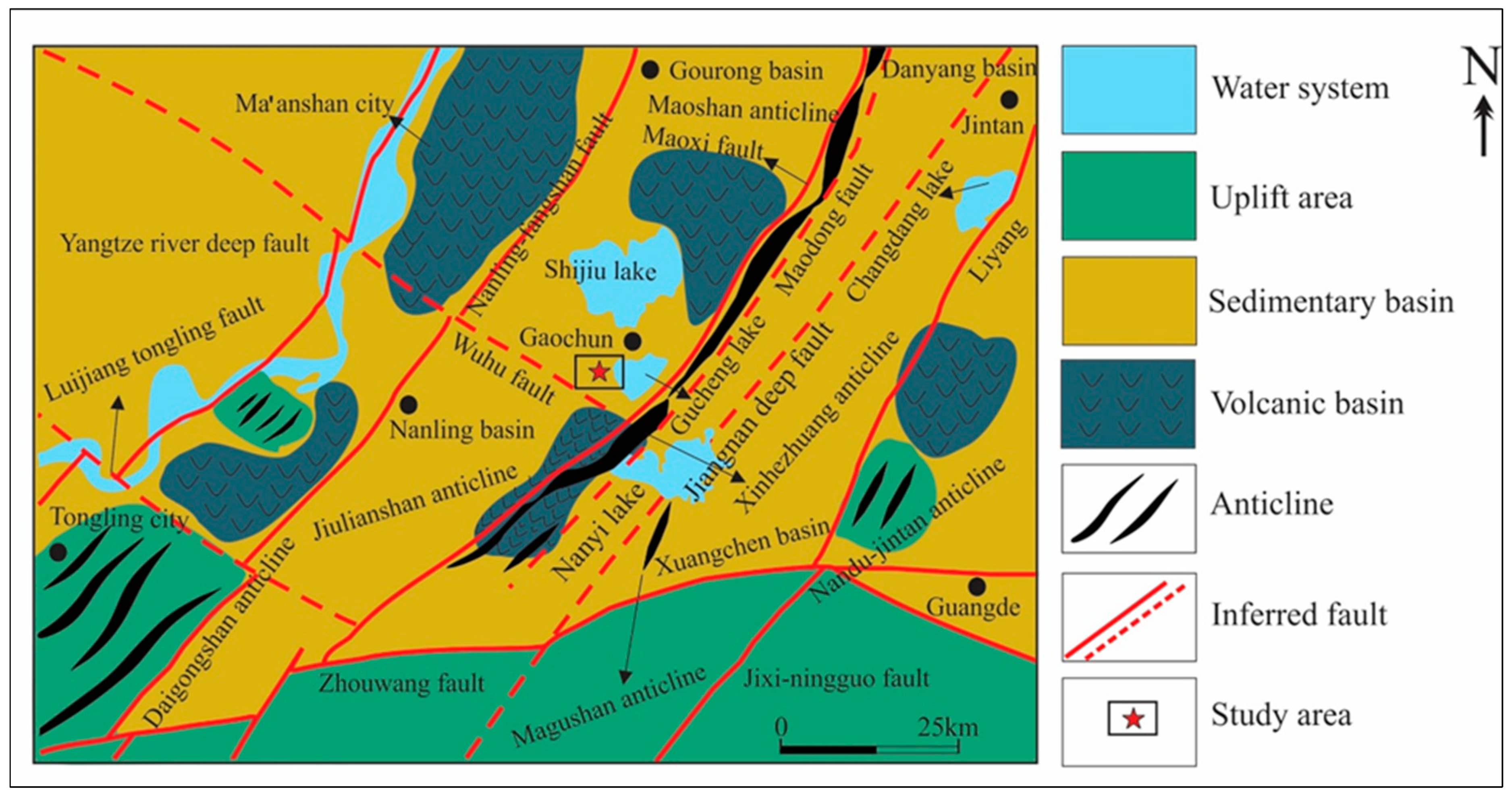
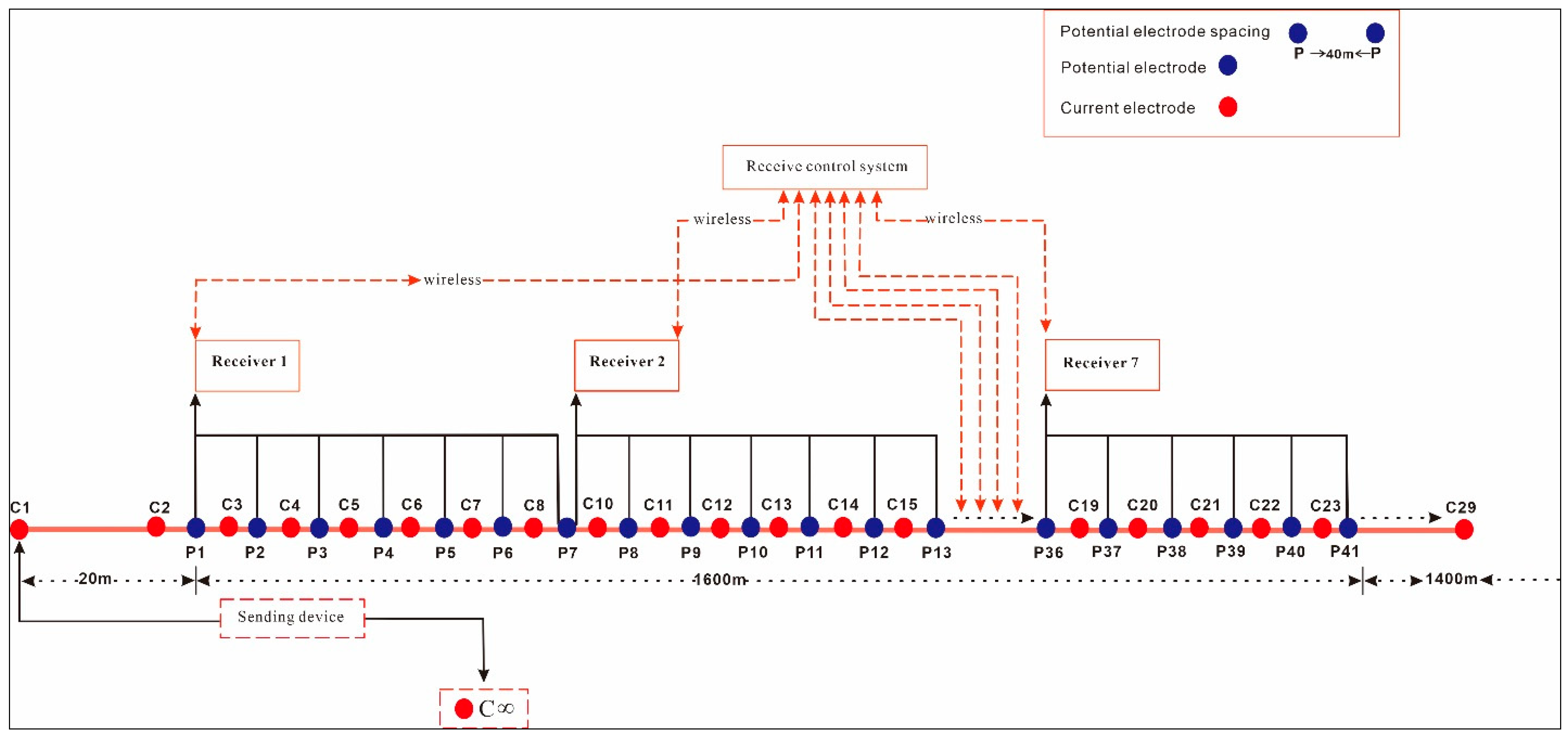
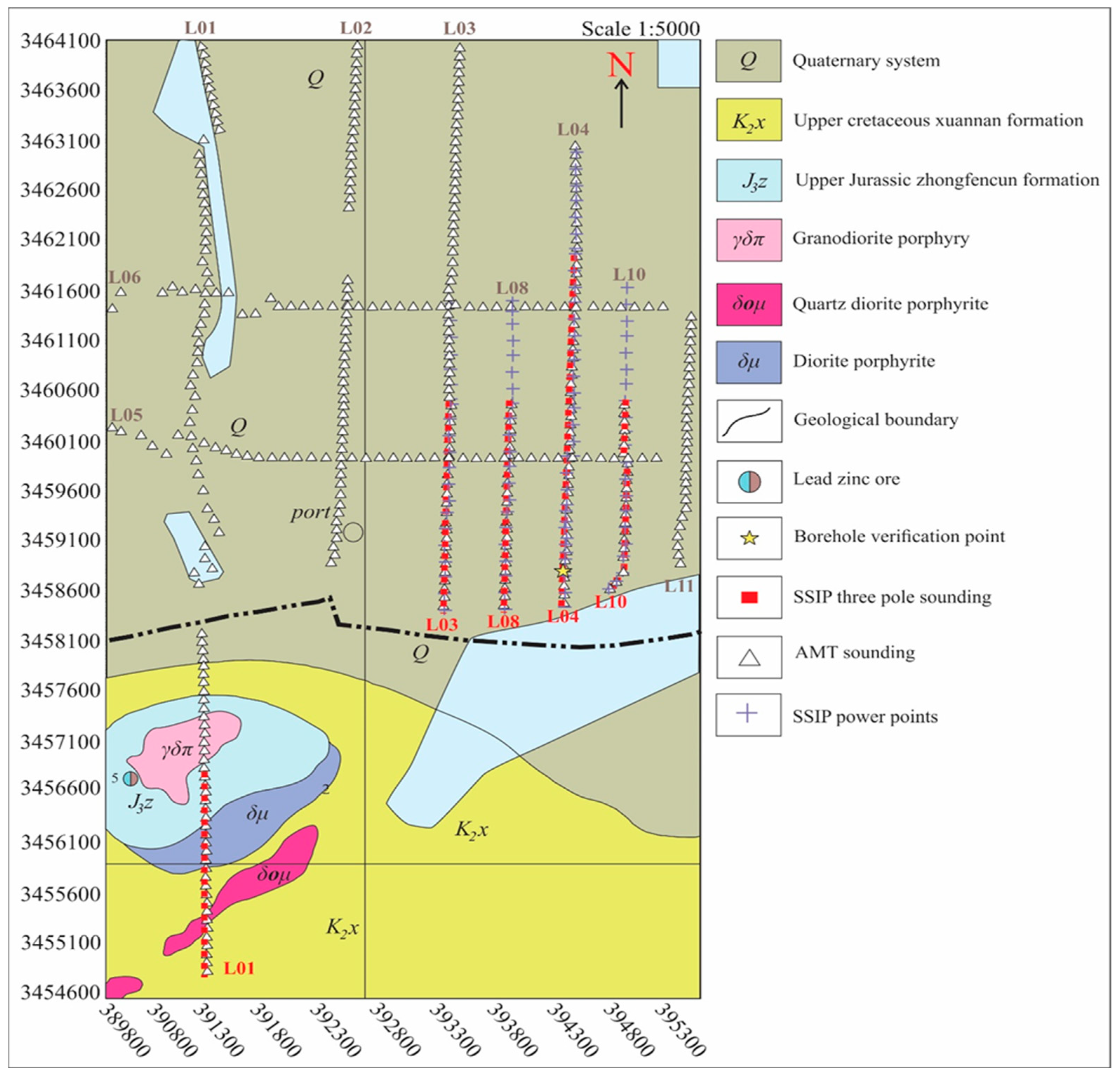
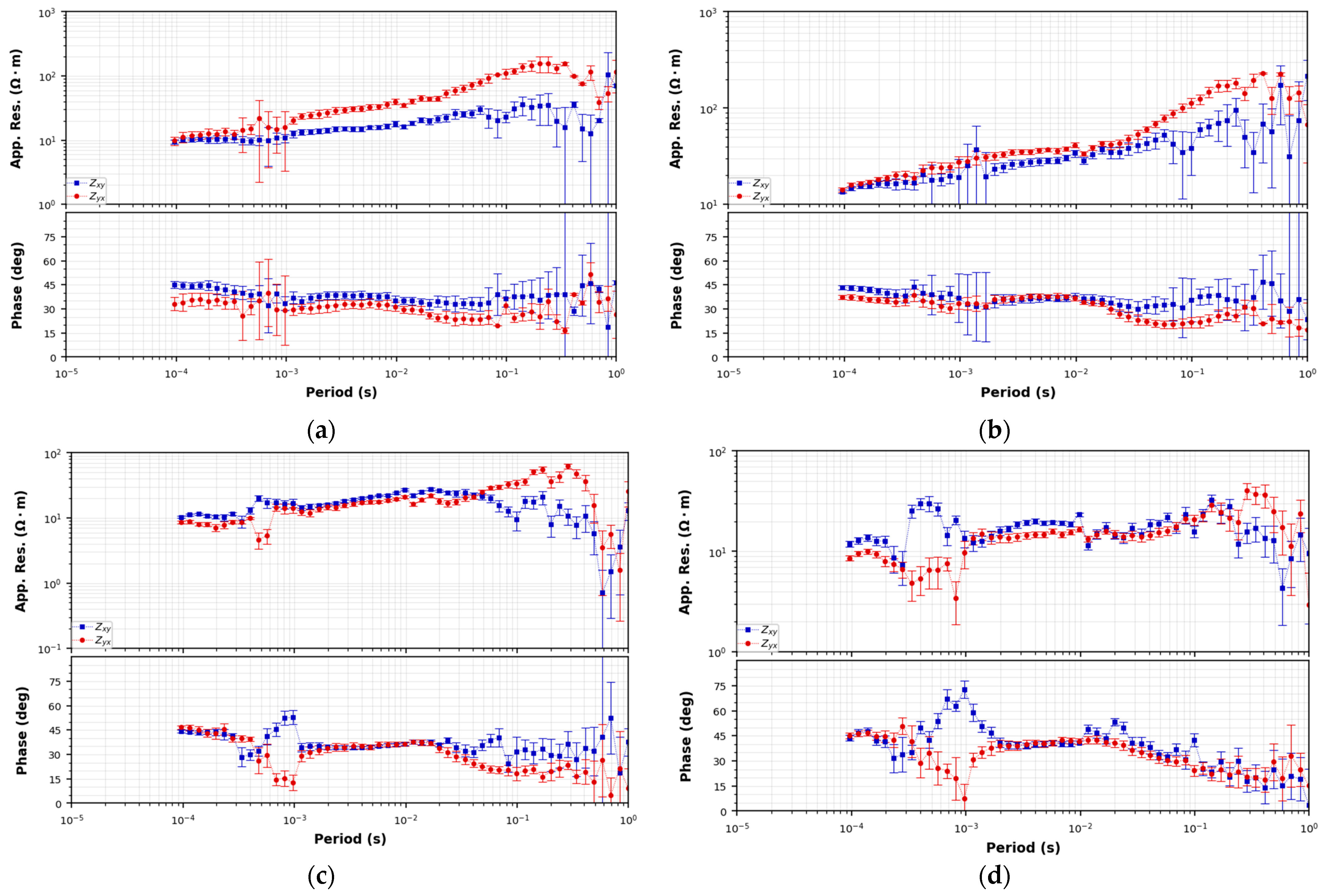


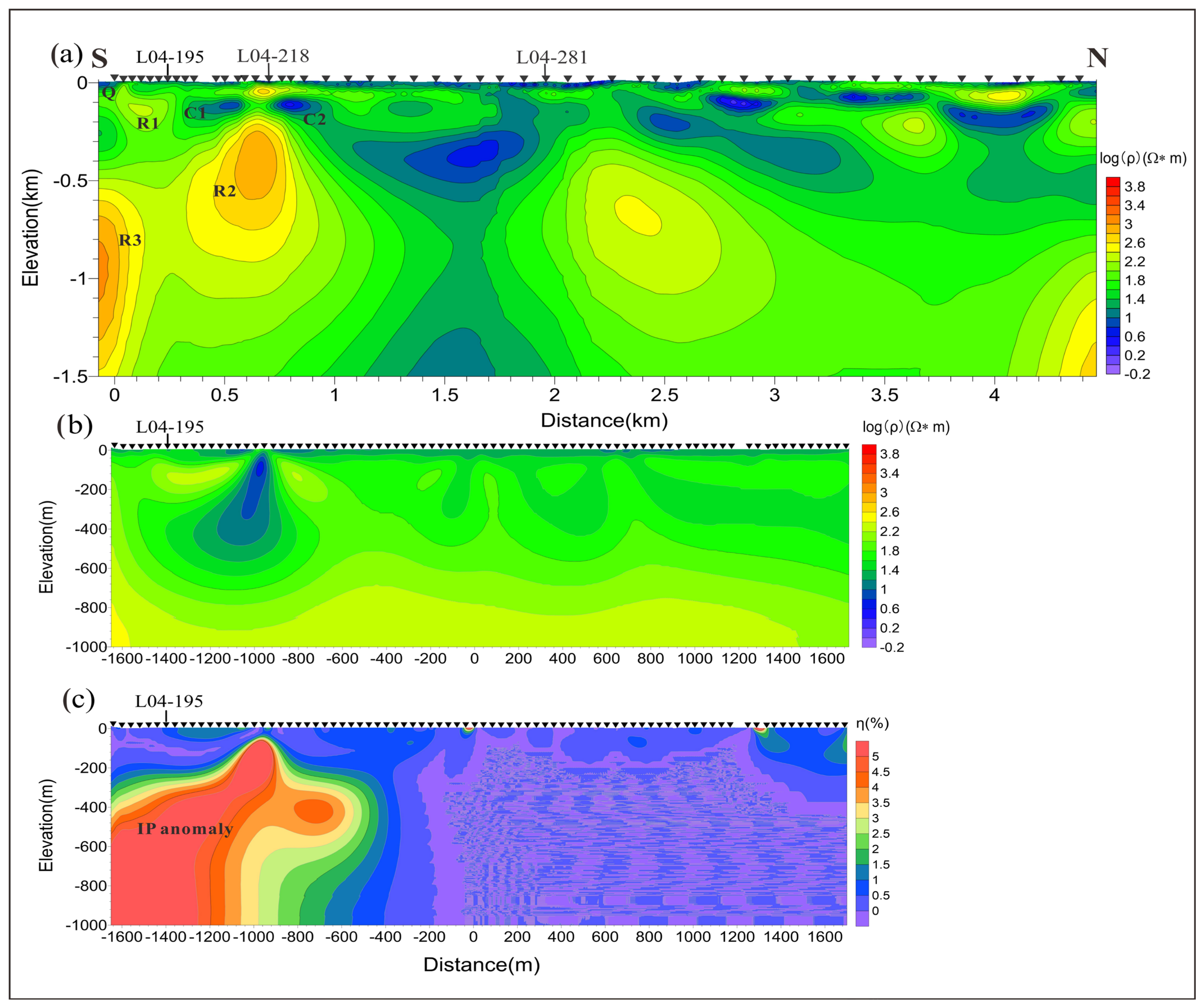


Disclaimer/Publisher’s Note: The statements, opinions and data contained in all publications are solely those of the individual author(s) and contributor(s) and not of MDPI and/or the editor(s). MDPI and/or the editor(s) disclaim responsibility for any injury to people or property resulting from any ideas, methods, instructions or products referred to in the content. |
© 2024 by the authors. Licensee MDPI, Basel, Switzerland. This article is an open access article distributed under the terms and conditions of the Creative Commons Attribution (CC BY) license (https://creativecommons.org/licenses/by/4.0/).
Share and Cite
Ullah, F.; Zhou, X.; Chen, R.; Yang, L.; Yao, H.; Hu, H.; Chen, S.; Wang, Q. Cu–Polymetallic Deposit Exploration under Thick Cover in Gucheng–Yaxi Area Using Audio-Magnetotelluric and Spread-Spectrum-Induced Polarization. Minerals 2024, 14, 846. https://doi.org/10.3390/min14080846
Ullah F, Zhou X, Chen R, Yang L, Yao H, Hu H, Chen S, Wang Q. Cu–Polymetallic Deposit Exploration under Thick Cover in Gucheng–Yaxi Area Using Audio-Magnetotelluric and Spread-Spectrum-Induced Polarization. Minerals. 2024; 14(8):846. https://doi.org/10.3390/min14080846
Chicago/Turabian StyleUllah, Farid, Xin Zhou, Rujun Chen, Lunkai Yang, Hongchun Yao, Hao Hu, Siwen Chen, and Quangong Wang. 2024. "Cu–Polymetallic Deposit Exploration under Thick Cover in Gucheng–Yaxi Area Using Audio-Magnetotelluric and Spread-Spectrum-Induced Polarization" Minerals 14, no. 8: 846. https://doi.org/10.3390/min14080846
APA StyleUllah, F., Zhou, X., Chen, R., Yang, L., Yao, H., Hu, H., Chen, S., & Wang, Q. (2024). Cu–Polymetallic Deposit Exploration under Thick Cover in Gucheng–Yaxi Area Using Audio-Magnetotelluric and Spread-Spectrum-Induced Polarization. Minerals, 14(8), 846. https://doi.org/10.3390/min14080846





